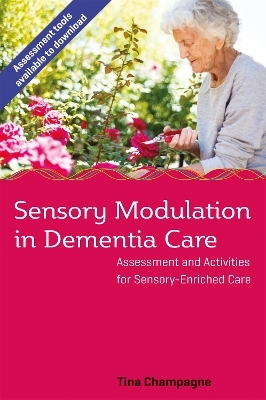
Sensory Modulation in Dementia Care
Jessica Kingsley Publishers (Verlag)
978-1-78592-733-1 (ISBN)
Understand and assess the sensory needs of people with dementia, and learn how to implement sensory modulation-based approaches for enriched care.
Drawing on the author's Sensory Modulation Program, this approach aids with self-organization and meaningful participation in life activities. Explaining sensory-processing issues specific to older populations, this book provides a downloadable assessment tool to help review individual sensory-processing patterns. It includes a range of sensory-based activities which can be carried out with people at all stages of dementia, both with individuals and in groups. The book also provides recommendations for modifying physical environments to make care settings sensory-enriched.
Tina Champagne is an international consultant, writer and occupational therapist who developed the Sensory Modulation Program. She lives in Massachusetts, USA.
Introduction. 1. Aging and Dementia. 1.1. Types of Dementia. 1.2. Stages of Dementia. 1.3. Hallucinations, Delusions and Paranoia. 1.4. The Stress Response. 1.5. Working with People with Dementia. 1.6. Restraint and Seclusion Reduction. 1.7. Trauma Informed Care. 1.8. International Initiatives in Dementia Care. 2. Aging and Sensory Processing. 2.1. Sensory Systems and Aging. 2.2. Sensory Integration and Processing. 2.3. Sensory Processing Umbrella. 2.4. Evidence-based Practice: Sensory-based Interventions. 3. The Sensory Modulation Program. 3.1. Introduction to the Sensory Modulation Program. 3.2. Sensory Modulation Program Components. 3.3. Sensory Modulation Program Goals. 3.4. Sensory Modulation Program Implementation: Individual & Programmatic Applications. 4. Assessment and Safety Considerations. 4.1. Safety Considerations and Trauma History. 4.2. Sensory-based Assessment and Screening. 4.3. Dementia, Cognitive and Other Assessments. 5. Sensorimotor Activities and Sensory-based Modalities. 5.1. Calming and Alerting Strategies. 5.2. Sensory Strategies Organized by Sensory Systems. 5.3. Safety Considerations. 6. Sensory Diets. 6.1. Sensory Diet: Supporting Safety, Comfort, and Participation. 6.2. Supporting Safety and Relaxation. 6.3. Supporting Self-care Participation. 6.4. Supporting Rest and Sleep. 6.5. Supporting Roles and Social Participation. 6.6. Supporting Fitness and Leisure Participation. 6.7. Individual and Programmatic Applications. 6.8. Sensory Diet Communication. 7. Environmental Modifications and Enhancements. 7.1. Enabling and Empowering Environments. 7.2. Homelike Environment. 7.3. Sensory Rooms. 7.4. Sensory Carts. 7.5. Sensory Kits. 7.6. Sensory Gardens. Resources. Appendix. References.
| Erscheinungsdatum | 18.04.2018 |
|---|---|
| Zusatzinfo | 15 black and white images |
| Verlagsort | London |
| Sprache | englisch |
| Maße | 156 x 229 mm |
| Gewicht | 255 g |
| Themenwelt | Medizin / Pharmazie ► Medizinische Fachgebiete ► Geriatrie |
| Medizin / Pharmazie ► Physiotherapie / Ergotherapie ► Ergotherapie | |
| Sozialwissenschaften ► Pädagogik ► Sozialpädagogik | |
| Sozialwissenschaften ► Soziologie | |
| ISBN-10 | 1-78592-733-7 / 1785927337 |
| ISBN-13 | 978-1-78592-733-1 / 9781785927331 |
| Zustand | Neuware |
| Haben Sie eine Frage zum Produkt? |
aus dem Bereich


